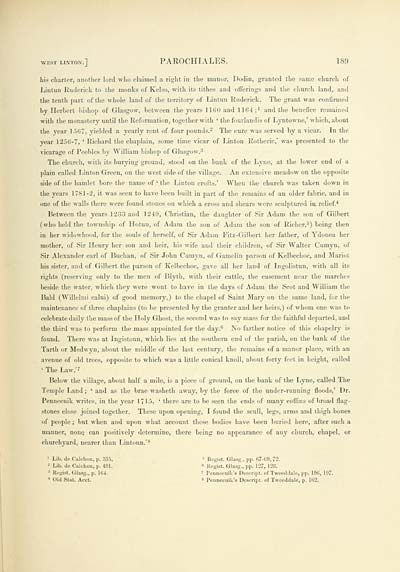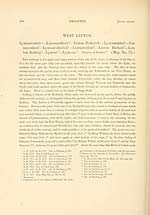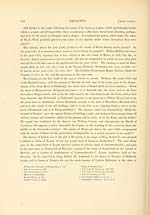Bannatyne Club > Origines parochiales Scotiae > Volume 1
(239) Page 189
Download files
Complete book:
Individual page:
Thumbnail gallery: Grid view | List view

WEST LINTON.] PAROCHIALES. 189
his charter, another lurd who claimed a right in the manor, Uodin, granted the same church of
Lintuu Ruderick to the monks of Kelso, with its tithes and offerings and the church land, and
the tenth part of the whole land of the territory of Lintun Ruderick. The grant was confirmed
by Herbert bishop of Glasgow, between the years 1160 and 1164 j^ and the benefice remained
with the monastery until the Reformation, together with ' the fourlandis of Lyntowne,' which, about
the year 1567, yielded a yearly rent of four pounds.- The cure was served by a vicar. In the
year 1256-7, 'Richard the chaplain, some time vicar of Linton Rotheric,' was presented to the
vicarage of Peebles by William bishop of Glasgow.^
The church, with its burying ground, stood on the bank of the Lyne, at the lower end of a
plain called Linton Green, on the west side of the village. An extensive meadow on the opposite
side of the hainlet bore the name of ' the Linton crofts.' When the church was taken down in
the years 1781-2, it was seen to have been built in part of the remains of an older fabric, and in
one of the walls there were found stones on which a cross and shears were sculptured i& relief.*
Between the years 1233 and 1249, Christian, the daughter of Sir Adam the son of Gilbert
( who held the township of Hotun, of Adam the son of Adam the son of Richer,") being then
in her widowhood, for the souls of herself, of Sir Adam Fitz-Gilbert her father, of Ydonea her
mother, of Sir Henry her son and heir, his wife and their children, of Sir Walter Cumyn, of
Sir Alexander earl of Buchan, of Sir John Cumyn, of Gamelin parson of Kelbechoc, and Mariot
his sister, and of Gilbert the parson of Kelbechoc, gave all her land of Ingolistun, with all its
rights (reserving only to the men of Blyth, with their cattle, the easement near the marches
beside the water, which they were wont to have in the days of Adam the Scot and William the
Bald (Willelmi calui) of good memory,) to the chapel of Saint Mary on the same land, for the
maintenance of three chaplains (to be presented by the granter and her heirs,) of whom one was to
celebrate daily the mass of the Holy Ghost, the second was to say mass for the faithful departed, and
the third was to perform the mass appointed for the day.** No farther notice of this chapelry is
found. There was at Ingistoun, which lies at the southern end of the parish, on the bank of the
Tarth or Medwyn, about the middle of the last century, the remains of a manor place, with an
avenue of old trees, opposite to which was a little conical knoll, about forty feet in height, called
' The Law.''
Below the village, about half a mile, is a piece of ground, on the bank of the Lyne, called The
Temple Land ; ' and as the brae washeth away, by the force of the under-running floods,' Dr.
Pennecuik writes, in the year 1715, ' there are to be seen the ends of many coffins of broad flag-
stones close joined together. These upon opening, I found the scull, legs, arms and thigh bones
of people ; but when and upon what account these bodies have been buried here, after such a
manner, none can positively determine, there being no appearance of any church, chapel, or
churchyard, nearer than Lintoun.'*
' Lib. de Calehou, p. .335. = Regist. Glasg., pp. 67-G9, 72.
- Lib. de Calehou, p. 491. " Regist. Glasg., pp. 1-27, 128.
' Regist. Glasg., p. 1()4. ' Peniiecuik's Descript. of Tweeddale, pp. 19G, 197.
* Old Stat. Acct. 3 Pennecuik's Descript. of Tweeddale, p. lb'2.
his charter, another lurd who claimed a right in the manor, Uodin, granted the same church of
Lintuu Ruderick to the monks of Kelso, with its tithes and offerings and the church land, and
the tenth part of the whole land of the territory of Lintun Ruderick. The grant was confirmed
by Herbert bishop of Glasgow, between the years 1160 and 1164 j^ and the benefice remained
with the monastery until the Reformation, together with ' the fourlandis of Lyntowne,' which, about
the year 1567, yielded a yearly rent of four pounds.- The cure was served by a vicar. In the
year 1256-7, 'Richard the chaplain, some time vicar of Linton Rotheric,' was presented to the
vicarage of Peebles by William bishop of Glasgow.^
The church, with its burying ground, stood on the bank of the Lyne, at the lower end of a
plain called Linton Green, on the west side of the village. An extensive meadow on the opposite
side of the hainlet bore the name of ' the Linton crofts.' When the church was taken down in
the years 1781-2, it was seen to have been built in part of the remains of an older fabric, and in
one of the walls there were found stones on which a cross and shears were sculptured i& relief.*
Between the years 1233 and 1249, Christian, the daughter of Sir Adam the son of Gilbert
( who held the township of Hotun, of Adam the son of Adam the son of Richer,") being then
in her widowhood, for the souls of herself, of Sir Adam Fitz-Gilbert her father, of Ydonea her
mother, of Sir Henry her son and heir, his wife and their children, of Sir Walter Cumyn, of
Sir Alexander earl of Buchan, of Sir John Cumyn, of Gamelin parson of Kelbechoc, and Mariot
his sister, and of Gilbert the parson of Kelbechoc, gave all her land of Ingolistun, with all its
rights (reserving only to the men of Blyth, with their cattle, the easement near the marches
beside the water, which they were wont to have in the days of Adam the Scot and William the
Bald (Willelmi calui) of good memory,) to the chapel of Saint Mary on the same land, for the
maintenance of three chaplains (to be presented by the granter and her heirs,) of whom one was to
celebrate daily the mass of the Holy Ghost, the second was to say mass for the faithful departed, and
the third was to perform the mass appointed for the day.** No farther notice of this chapelry is
found. There was at Ingistoun, which lies at the southern end of the parish, on the bank of the
Tarth or Medwyn, about the middle of the last century, the remains of a manor place, with an
avenue of old trees, opposite to which was a little conical knoll, about forty feet in height, called
' The Law.''
Below the village, about half a mile, is a piece of ground, on the bank of the Lyne, called The
Temple Land ; ' and as the brae washeth away, by the force of the under-running floods,' Dr.
Pennecuik writes, in the year 1715, ' there are to be seen the ends of many coffins of broad flag-
stones close joined together. These upon opening, I found the scull, legs, arms and thigh bones
of people ; but when and upon what account these bodies have been buried here, after such a
manner, none can positively determine, there being no appearance of any church, chapel, or
churchyard, nearer than Lintoun.'*
' Lib. de Calehou, p. .335. = Regist. Glasg., pp. 67-G9, 72.
- Lib. de Calehou, p. 491. " Regist. Glasg., pp. 1-27, 128.
' Regist. Glasg., p. 1()4. ' Peniiecuik's Descript. of Tweeddale, pp. 19G, 197.
* Old Stat. Acct. 3 Pennecuik's Descript. of Tweeddale, p. lb'2.
Set display mode to: Large image | Transcription
Images and transcriptions on this page, including medium image downloads, may be used under the Creative Commons Attribution 4.0 International Licence unless otherwise stated. ![]()
| Publications by Scottish clubs > Bannatyne Club > Origines parochiales Scotiae > Volume 1 > (239) Page 189 |
|---|
| Permanent URL | https://digital.nls.uk/81025852 |
|---|
| Description | Volume first. Diocese of Glasgow. |
|---|---|
| Shelfmark | SCS.BC.97 |
| Additional NLS resources: | |
| Attribution and copyright: |
|
| Description | Place of publication Edinburgh unless otherwise stated. No. 125 is relative to but not part of the club's series. |
|---|---|

